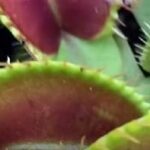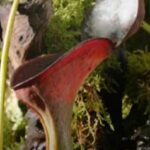As an Amazon Associate, this site earns commissions from qualifying purchases. For more details, click here.
Seeing the pitchers on your nepenthes turn crispy brown can be an alarming sight. Those are the traps used by the plant to catch and eat bugs, so there is clearly something wrong here. What could be the reason for this and is there anything you can do about it? Actually there are a few things you can do to save those pitchers, and that is what this article is about.
Pitchers on pitcher plants turn brown due to lack of humidity, insufficient water or both. The brown color means the pitcher is getting dry because there is not enough water and humidity in the soil.
Pitcher plants use a lot of energy to make pitcher traps. If they lack the resources the plant will stop producing these traps and focus on other vital functions. The remaining pitchers will dry, turn brown and eventually fall off. Fortunately there are ways you can fix this problem.
More Water is Needed
Both nepenthes and sarracenia pitchers need water to keep the soil moist. If you let the soil dry out it will not only turn the pitcher brown but also kill the plant.
Watering pitcher plants can prevent the pitchers from turning brown. By keeping the soil moist, the humidity increases around the plant. Pitchers produce liquids to trap and digest insects, but this is only possible if there is enough water to go around.
Water the plant until the liquid emerges from the drainage. Next, use a soil moisture meter to ensure the soil is moist, not too wet or too dry. Just press the water meter 7-8 inches into the soil and it will indicate the moisture status on the readout.
If you do not have this device, use a hand held shovel. Stick it a few inches into the soil and pull it out. If the shovel is sticky and wet, the soil is too wet. If there is no dirt, the soil, add more water. But if there are bits of soil hanging on the shovel, then the soil is moist.
How long pitcher plants live is determined in large part by how much water it receives. So if you notice any of the pitchers appear brown, this is the first place to look. If you check the other leaves on the plant you may notice they are turning brownish as well.
Those are indications the plant is not getting enough water. This can be a real problem for nepenthes and sarracenia since both of them require lots of light. If it is exposed to a warm temperature with little water, then its pitchers will dry out.
Increase Humidity
Pitcher plants require a 50% or higher humidity level. The hotter the temperature, the higher the humidity level required. Nepenthes require slightly higher humidity levels than sarracenia, but this can vary according to the species.
Because there are many pitcher plant species, there is no one size fits all approach to humidity. What all these plants share in common is that it is a necessity. Just like water, not enough humidity affects pitchers and can cause them to lose color.
Watering pitcher plants can increase humidity. How much control you have over this depends on whether the plant is indoors or outdoors. If your pitcher plants are indoor you can install an AquaOasis Cool Mist Humidifier to maintain the humidity.
If your pitcher plants are outdoors, there is nothing much you can do about the humidity. Unless you have a greenhouse for your plants, which will allow you to control every aspect of its environment.
Keep in mind too that nepenthes are tropical plants and do not go dormant. They cannot survive long harsh winters outdoors. Nepenthes thrive in the same temperature and humidity all year round which makes them ideal for indoor cultivation. This also makes their pitchers easy to care for.
Sarracenia on the other hand, requires dormancy. They can survive outdoors during winter, but if indoors you have to provide them with a suitably cold location. Or you have to move them outdoors so it can go dormant.
What does this have to do with pitchers turning brown? It means that your hardiness zone directly affects the ability of pitcher plants to create pitchers. You have to make sure there is sufficient humidity so the traps can retain moisture and produce fluids inside.
Proper Feeding and Nutrition
The type of pitcher a nepenthes produces is indicative of its health. Robust, colorful pitchers is a sign of good health while brownish pitchers means it lacks water, humidity or even food.
Pitcher plants do not have to eat bugs to survive, but without it they will be rather weak. They will conserve energy and use it for the most basic tasks only. Pitchers will be one of the first to suffer from lack of nutrition as the plant allocates its resources elsewhere.
These carnivorous plants developed pitchers specifically to trap flies, gnats, mosquitoes and other bugs. Sweet nectar is spread around the pitcher to attract the attention of insects. A bug that attempts to eat the nectar falls into the pitcher and gets eaten. To be more accurate, the plant dissolves the insect and absorbs it.
However, pitcher plants can only make these traps if they have additional resources available. Their basic food or energy source is glucose, which they create through photosynthesis. But that is only for handling its daily activities.
To keep pitchers healthy, nepenthes and sarracenia require additional sources of nutrition. This is where insects come in as they provide the supplements these plants require.
To put it another way. If pitcher plants do not get a chance to eat bugs, there is no reason for them to produce pitchers. If they get to feed regularly, then they will produce more pitchers.
Pitcher plants do not require a lot of bugs. Feed the plant at least once a month and it will be enough to generate pitchers. Feed it 2-4 times a month and that will make the pitchers even stronger and healthier.
Tips How to Prevent Pitchers From Turning Brown
There are other ways to keep pitchers from turning crisp. Try the following along with the tips given earlier to get the most out of your pitcher plants.
Use the Proper Soil
Pitcher plants grow best in peat moss and perlite or long sphagnum moss and silica sand (1:1). Do not use rich soil. Fertilized soul is bad for pitcher plants and must be avoided at all costs.
Ensure the soil is mixed thoroughly and has good drainage. The pot can be any size, but keep in mind that as the plant grows larger, it may outgrow the container.
You can buy the soil materials separately and mix them. A more practical approach is to purchase potting soil that is already mixed. Now you just need to plant your nepenthes or sarracenia and not worry if the ix ratio is correct. On of the better carnivorous soil mixes available is Soil Sunrise Carnivorous Mix.
Light
Too much light can burn pitcher plants, so you have to strike a balance here. If you notice the pitchers turn brown, crispy and dry, it could be too much direct light.
The ideal temperature for pitcher plants is 65-90 F. Some species can thrive in 95 or 100 F as long as there is enough humidity.
In general, nepenthes prefer full to direct light, while sarracenia grows better under full light. Natural is recommended though both will live under grow lights.
A few more tips to keep those pitchers healthy:
- Do not touch the pitchers. Do not put your finger in the liquid. You will not be harmed but it will put the plant under stress.
- Do not give pitcher plants any sort of fertilizer food.
- Adding a bit of water to pitcher plants is not going to harm it. But do not fill it to the brim. If the pitcher lacks water, it requires higher humidity.
- Do not sit these plants in several inches of water. This will not help the pitchers. in fact this could lead to root rot.
- Pitchers that are less than 50% brown can still recover. So act quickly.
- If the trap cannot be saved, just cut it off. A new one will take its place.
Conclusion
There is no need to panic if you see a pitcher suddenly turn brown. As was explained here, the solution can be quite simple. The key of course is to act as quickly as possible to prevent it from happening again.

My fascination with carnivorous plants began many, many years ago with Venus Fly Traps. Now I am more than happy to impart what I know with other enthusiasts and those who are curious about meat eating plants.



